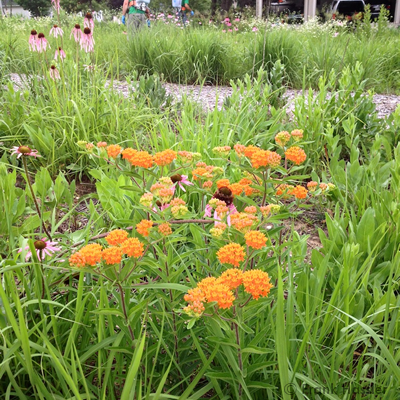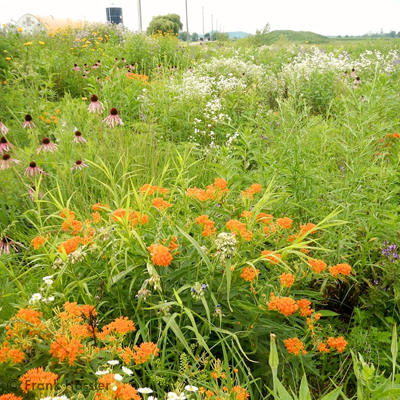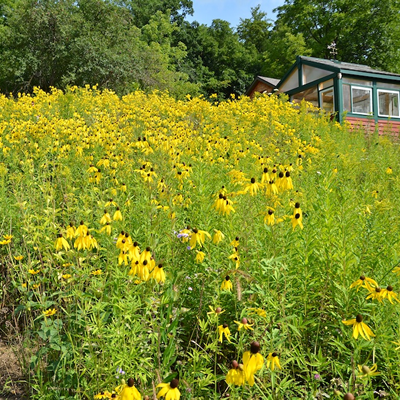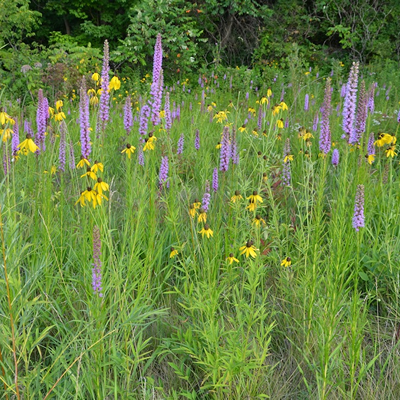Prairie Restoration
- The Historic “Sea of Grass”
- Prairie Restoration: Conservation in Action
- Top
TenFifteen Reasons To Plant a Prairie - The Process of Planting a Prairie
- Books to Read
The Historic “Sea of Grass”
For 10,000 years the tallgrass prairie was the dominant ecosystem in the Midwest. This landscape was sculpted by regular fires which returned nutrients to the soil and suppressed woody plants that might invade the prairie, resulting in a rich and lush grassland. Prairies were home to hundreds of species of grasses and flowering plants. These prairie plants were fodder not only for large mammals, but for thousands of species of insects ranging from bees and butterflies to lowly beetles and bugs, which in-turn fed and dozens of species of songbirds, many of which can only make their homes in grasslands.
When the first settlers arrived almost 200 years ago they found what could only be described as a “sea of grass”. There was no word for this landscape in English, so “prairie” was taken from the French word for “meadow”. These industrious settlers made the land agriculturally productive and built our communities. But in that effort, the prairies were tilled under. Today less than 0.5% of the tallgrass prairie remains in Wisconsin. Conservation of the last remaining remnants is critical to preserving the genetic legacy of our landscape. Reconstructing new prairies offers the opportunity to payback what we’ve borrowed from mother nature.


Prairie Restoration: Conservation in Action
The challenge of re-establishing an entire ecosystem is a daunting one. Most large mammals and many game birds have been lost from our landscape while many grassland songbirds such as bobolinks, meadowlarks, prairie chickens and the Henslow’s sparrow tenuously hang on to survival. The science and practice of ecological restoration, now a global effort, began right here in southern Wisconsin over 80 years ago with efforts by ecologists such as John Curtis and Aldo Leopold. Even after generations of prairie restoration efforts, it is still a challenge to create reconstructed prairies that look and function like the real thing. The staff of Good Oak Ecological Services is on the cutting edge of this ever-changing field. We have worked with and learned from some of the greatest minds in ecological restoration. Now we are ready to use what we have learned to help you.


Top Ten Fifteen Reasons To Plant a Prairie
Conserve Water: According to the U.S. E.P.A. even here in the Midwest, up to 30% of our drinking water is used to water lawns! Prairies don’t require any watering once established, conserving 300,000 gallons per acre per year compared to irrigated turf!
Clean Lakes and Streams: Lawns use ten times as many chemicals per acre as industrial farmland. Our local lakes and streams are highly polluted from both farm and urban run-off.
Clean Groundwater: Prairies capture rainwater where it falls, allowing it to slowly percolate into the soil where it is cleaned and cooled, naturally percolating into groundwater stores. Your great-grandchildren will thank you.
Flood Mitigation: Prairie vegetation in retention swales and basins can absorb some of the pollutants from run-off from the surrounding landscape with a much greater water infiltration rate than lawn or exotic grasses typical found in theses storm water features.
Wildlife Habitat: Prairies provide homes to a range of wildlife ranging from game species to songbirds to pollinators, and many, many more that you might not notice, but who are working to keep the ecosystem running.
Natural Education: One study showed that children could identify 1000 corporate logos but fewer than 10 plants or animals native to their region. Prairies bring life to backyard or community for everyone to explore and enjoy.
Less Air Pollution: According to the U.S. E.P.A. up to 33% of all air pollution in urban areas is from lawn care machinery. Prairies don’t need no stinkin’ lawn care equipment.
Actually Cleaning the Air: Plants actually absorb air pollution, and prairies are a very productive plant community.
Erosion Control: The complex mesh of prairie roots uniquely excel at stabilizing soil and preventing erosion. Prairies don’t just prevent erosion, they actually build rich, organic soil.
Healthy Soils: Tough prairie roots, break up compacted soils. They add organic matter, and the spaces, oxygen and nutrients they impart upon the soil make homes for invertebrates and microbes. This rebuilds soil structure and fertility in degraded urban and agricultural soils, allowing it to absorb and hold water better, and be more productive.
Carbon Sequestration: Deep roots move carbon-rich organic compounds deep into the soil, where it is unavailable to impact our atmosphere. Prairies reduce climate change.
Save Time and Money: Large properties can save 25%-67% on land management over a ten year period by converting lawn to prairie. And any home-owner can benefit by spending less time pushing the lawn mower around every week.
Natural Beauty: Beauty is in the eye of the beholder. But its hard to argue with elegant prairie grasses and dozens of species of cheery wildflowers, blooming throughout the growing season. Prairies are even fun to watch in the winter as wildlife forage among the dormant vegetation.
Be Happy: Natural settings are shown to reduce stress and promote happiness making them a good choice for your home or business. Show your commitment to the health of your community with a natural prairie planting.
Perhaps the best reason to plant a prairie is because it feels good to do something to make the world a better place.
The Process of Planting a Prairie
When you plant a prairie, you are actually establishing an ecosystem. This takes careful management and patience. Typically we see the prairie matrix develop within three to five years.
1) Site Evaluation (Year 0)
We’ll evaluate the existing ground cover, soil texture, soil moisture level, lighting conditions and surrounding landscape and develop the best seed mix and planting plan to make your prairie a success.
2) Site Preparation (Year 0)
Existing perennial vegetation like brome, quack grass, Canada thistle, tall goldenrod, lawn grasses and other invasive plants can be hard to kill. In a cultivated field there can be from 56 to a whopping14,864 weed seeds per square foot of soil! This makes it clear why eliminating these plants before they can compete with the prairie seedlings is the most critical step in the success of a prairie planting. Tilling, burning, and herbicide application are all tools we may use over the course of a few weeks, or even up to two growing seasons, depending on site conditions.
3) Seeding (Year 1)
This is when it gets exciting! We’re reintroducing indigenous prairie plants to their original landscape. It’s the Midwest version of replanting the rainforest. We promote high diversity seed mixes, with over 50 species per mix, and potentially several mixes if conditions vary across the site. A diverse seed mix chosen for the specific conditions of the site will result in a more robust, ecologically stable, and beautiful prairie that will provide the greatest variety of wildlife resources and best reflect the natural history of our region.
4) Early Weed Management (Year 1-4)
Even after thorough site preparation, weed seedlings might outnumber prairie seedlings 10 to 1 in the early years of a prairie planting. We can differentiate the good guys from the bad guys right from the seedling stage, and we know which weeds will need management, and which will be harmless. Mowing annual weeds is the most common management tool in the first year. Spot herbicide application and hand weeding are common techniques in years two to four as we deal with biennial and perennial weeds.
5) Reintroducing Fire (year 3-4)
Once we can initiate prescribed burns things quickly turn in favor of the prairie species. As soon as enough dead plant material (aka fuel) builds up, we like to burn annually for a few years to really kick-start things, and then reduce fire frequency once the prairie is well established.
6) Long-Term Stewardship (Year 4+)
Your prairie planting, no matter how large, is just a tiny patch in a world full of invasive plants and ecological disturbances. As the prairie matures, maintenance needs are reduced significantly. But monitoring, early detection and controlling small patches of invasive plants will prevent big problems down the line. Prescribed burns should be conducted every 1-3 years. Continually adding new species by seed or by planting will increase the diversity, beauty and ecological stability of the site.
Prairie Stewardship Services
Prairie Remnant Restoration
The little bits of prairies that are still holding on to our Driftless slopes and valleys are priceless and irreplaceable gems of biodiversity. It would be our honor to help you restore them.
Prescribed Burning:
Safe, well planned and expertly executed; prescribed fires are a critical tool used to restore and maintain prairies and all Midwestern plant communities.
Brush Clearing:
Whether it’s in a prairie, savanna or woodland, invasive brush like buckthorn and honeysuckle, and weedy trees shade out our natural habitats. We’re skilled sawyers who can turn this situation around.
Prairie Resuscitation:
We’ve become skilled at resuscitating prairie plantings that have gone wrong. Too weedy or too grassy? We can bring it back to vitality.
Invasive Species Management:
We’re experts on controlling weeds from aggressive invasive plants to out-of-control garden perennials.
Erosion Control:
Native grasses and wildflowers have an unmatched ability to hold and regenerate soil. Coupled with wildlife-friendly, biodegradable materials, we can stabilize steep slopes and loose soil.
Books to Read
A Sand County Almanac by Aldo Leopold
Miracle Under the Oaks by William K. Stevens
The Tallgrass Restoration Handbook edited by Steven Packard and Cornelia F. Mutel